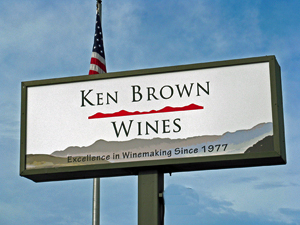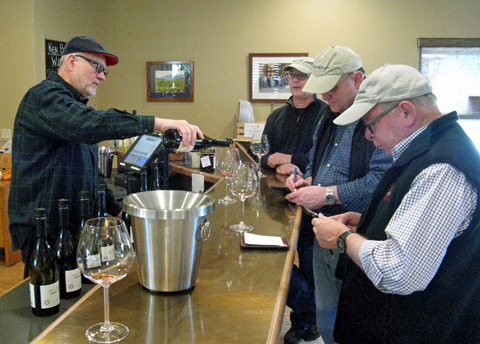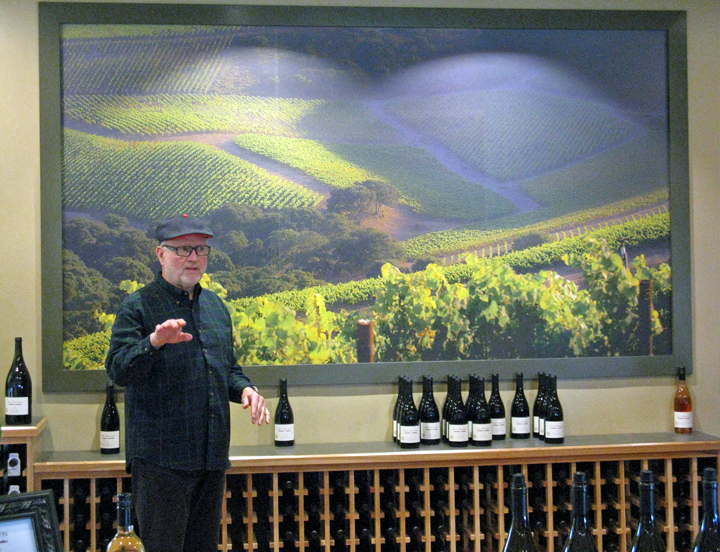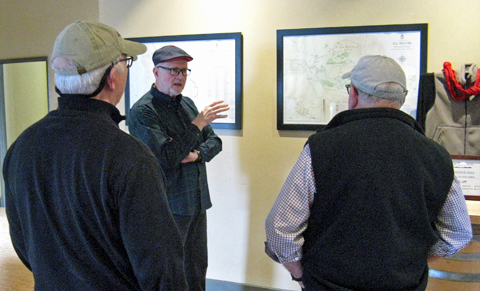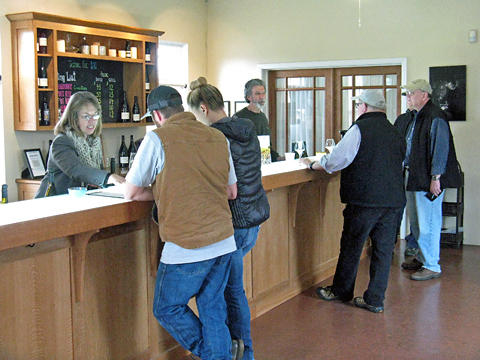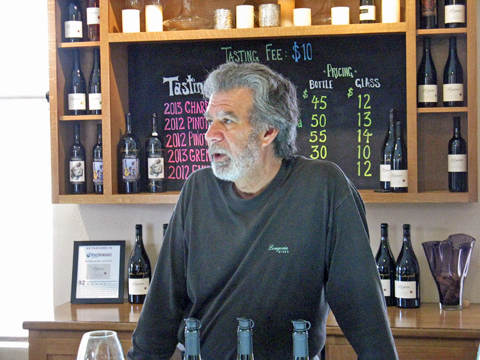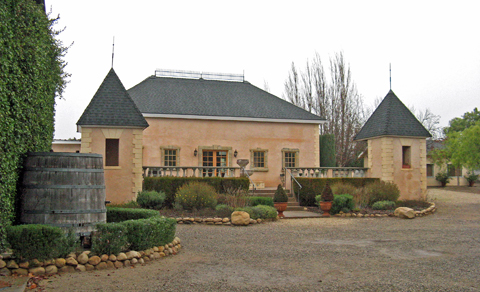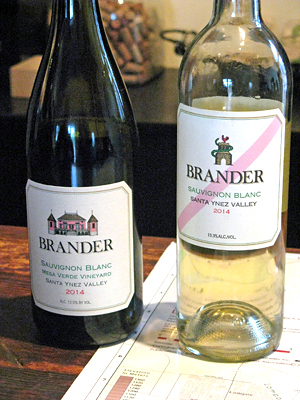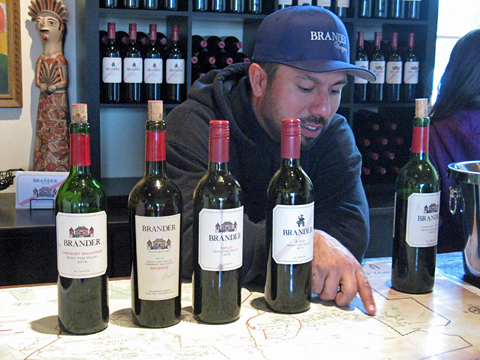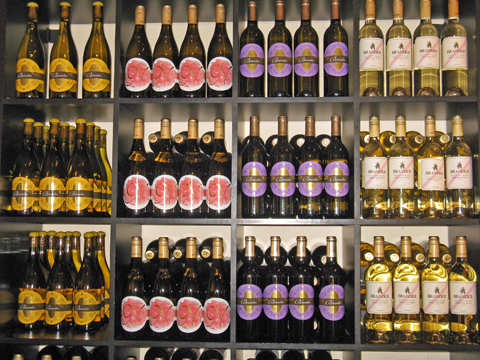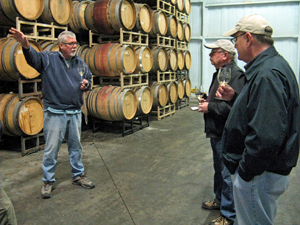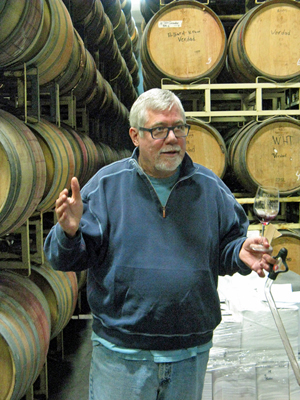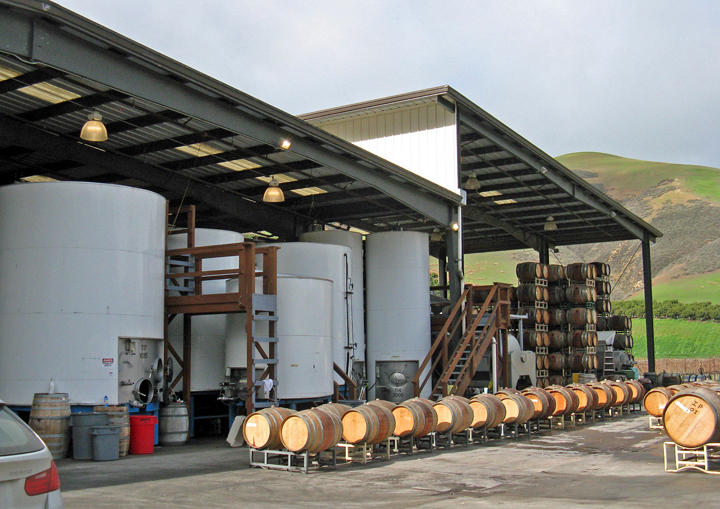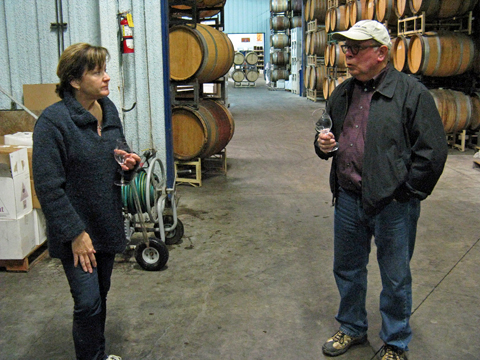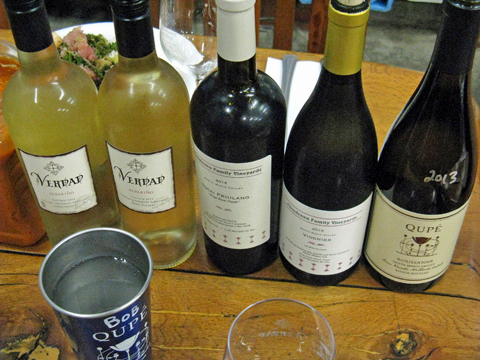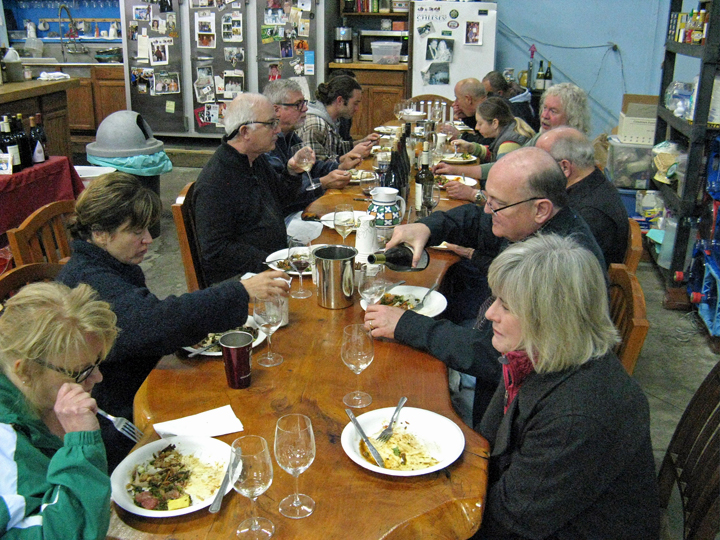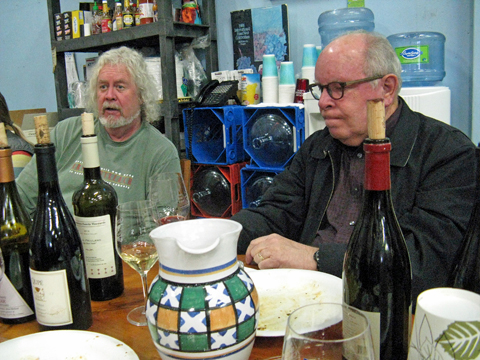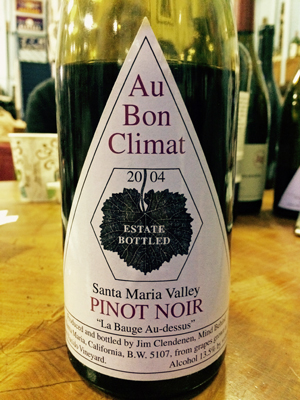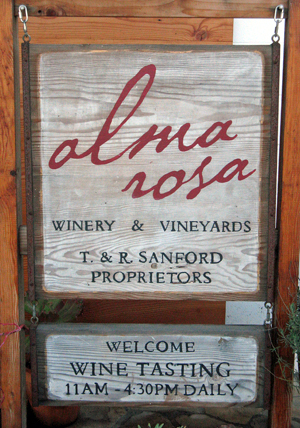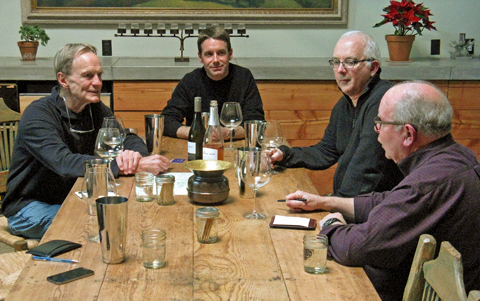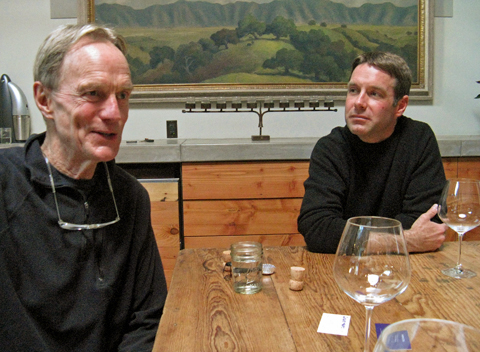Pioneers of Santa Barbara County Wine - January 2016
Grape-Nutz colleague Eric Anderson had talked with me late in 2015 about doing another January Central Coast wine tour, and that sounded like a great idea to me. We decided to get together a smaller group than we’d had for some past Central Coast trips – this time it was just Eric, his friend Michael, my friend Alan, and me.
As we usually do on these multi-day wine tours, we checked out a number of newer and lesser-known producers as well as a couple of more established ones – those visits are covered in a separate two-part Grape-Nutz report entitled “Central Coast – January 2016.” But I thought this trip might also be a great opportunity to visit some of the area’s wine pioneers, specifically from Santa Barbara County. I was fortunate enough to be able to arrange visits with a number of them, and it made sense to do this separate write-up for those visits.
Since Eric and Michael were driving up from Southern California while Alan and I were headed south from the Bay Area, we met about midway between, in Paso Robles. We spent the first 1-1/2 days of our trip visiting wineries in the Paso area before continuing to Santa Barbara County for a couple more stops on day 2. We made the Quality Inn in Buellton our home base for the next couple of days, during which we visited the wineries and tasting rooms of some of the best-known pioneers of Santa Barbara County wine. Ken Brown, Rick Longoria, Fred Brander, Jim Clendenen, Bob Lindquist, and Richard Sanford all started working in the wine industry in Santa Barbara County in the 1970s, and all established their own wineries by the early 1980s. With the exception of Fred Brander (he was out of town but arranged for us to meet with his winemaker Fabian Bravo) we were able to visit all of these legendary vintners on this trip.
This might be a good place for a brief introduction to the wine history of Santa Barbara County. The earliest Vitis Vinifera grapevines were brought to California by the Spanish in the late 1700s. These vines were almost certainly the variety known today as Mission in California, and recently identified as the somewhat obscure Spanish variety Listan Prieto – the variety goes by different names in various locations, such as Pais in Chile. The grapevines were grown in what is now Santa Barbara County at the Spanish Missions and at a handful of other sites. The first commercial vineyard in the area was established in the 1790s, thought viticulture did not really take off until the second half of the 1800s. It was during this period that other European grape varieties joined Mission in the vineyard. The oldest commercial grapevines in the region may well be the Mission vines planted in 1887 at Deborah Hall’s Gypsy Canyon Winery – the vines had been long-forgotten when the property was being restored in the 1990s, and they’re now once again producing fruit.
Prohibition wiped out most of Santa Barbara County’s vineyards and wineries, though a handful of small local “basement wineries” survived and remained active into at least the 1940s. But the rebirth of the region’s wine industry really began with the establishment of Santa Barbara Winery by Pierre Lafond in 1962. He originally made wine from fruit sourced elsewhere – including Zinfandel from the Templeton area – since there were no winegrapes available yet in the area. The first commercial vineyard was planted by Bill DeMattei and Uriel Nielson in 1964, on part of the old Rancho Tepusquet property on Santa Maria Mesa, north of the Sisquoc River. The original plantings included Riesling, Sylvaner, Chardonnay, Sauvignon Blanc, and Cabernet Sauvignon. The vineyard is still producing fruit – it’s well-known for its Chardonnay – and that general area is now one of the largest winegrape-growing portions of Santa Maria Valley.
A few other vineyards were planted by 1970, including Rancho Sisquoc and Tepusquet Vineyard – the latter site was later divided, with parts going to Jackson Family Wines among others. Tepusquet was originally planted by the Lucas brothers – Louis Lucas still grows winegrapes in the county and co-owns Lucas & Lewellen. But the early- to mid-1970s saw a planting boom in the county, including many vineyards still familiar today, including Vega (Bill Mosby’s vineyard), Lafond, Sanford & Benedict, Bien Nacido, Firestone, Zaca Mesa, Brander, plus many others that are no longer as well-known or that have changed ownership and name. Interestingly, in 1971 the most widely-planted red grape variety in Santa Maria Valley – by a wide margin – was Cabernet Sauvignon, while Riesling was followed closely by Chardonnay among white varieties. As elsewhere in California, it took time for appropriate varieties to be planted in the right areas, and most of those early Cabernet plantings were at sites too cool for it to ripen properly.
The boom in new vineyards was soon followed by the founding of many pioneering wineries of the region from the mid-1970s to mid-1980s, among them Firestone, Zaca Mesa, Rancho Sisquoc, Brander, Mosby, Hartley-Ostini Hitching Post, Sanford, Au Bon Climat, Qupé, Longoria, Byron, Gainey, Babcock, and Foxen. Naturally, some of the wineries in that first wave of growth have either closed or have been bought and renamed, including Los Alamos Vineyards, Tepusquet, Sanford & Benedict, Santa Ynez Winery (now Kalyra), Ballard Canyon Vineyard (now Rusack), J. Carey (now Lincourt), Austin Cellars, Houtz (now Beckmen), and others.
The Sunday morning of our wine trip was clear and bright, and it looked like we were in for a day of sunny and warm weather. Our motel stay included breakfast…ah, nothing like a motel breakfast! And although the choices were pretty much what you’d expect, the food actually wasn’t bad at all by motel breakfast standards. Since Eric’s car has a roomier back seat than mine does, he volunteered to drive us for the day, so shortly before 10am we assembled in front of the motel to start the day’s tour.
| Sunday
- January 17, 2016 |
Ken Brown
Tasting Notes: Current Releases |
Ken Brown 2013 Chardonnay, La Rinconada Vineyard, Sta. Rita Hills. Light straw color, featuring pear and stone fruit aromas with a well-integrated vanilla/oak component. Medium-bodied with bright acidity and a clean finish, nice.
Ken Brown 2013 Pinot Noir, Santa Barbara County. Lighter ruby color, this had cherry and rhubarb, earth, smoke, and floral undertones. Medium-light weight with a lively mouthfeel and finish.
Ken Brown 2013 Pinot Noir, Sta. Rita Hills. Slightly darker color, with a darker fruit profile and more earthy character. Medium-bodied with a richer texture than the previous wine, and fairly mild tannins on the finish.
Ken Brown 2013 Pinot Noir, Rita’s Crown Vineyard, Sta. Rita Hills. Medium-light ruby, showing darker berry fruit, earth, tea leaf, and a floral note. Medium weight on the palate with more structure than the first two Pinots, finishing with refined tannins – very promising and should age nicely.
Ken Brown 2013 Pinot Noir, La Encantada Vineyard, Sta. Rita Hills. Slightly lighter color, this displayed black cherry and plum with an earthy, forest floor note. Medium-bodied with plenty of bright acidity and a moderately tannic finish – this could use more time to come together.
Ken Brown 2012 Pinot Noir, Radian Vineyard, Sta. Rita Hills. Medium-light ruby color, showing black cherry and darker fruit, earth, and smoke. Plenty of structure and acidity, this finished with grippier tannins.
Ken Brown 2012 Pinot Noir, Clos Pepe Vineyard, Sta. Rita Hills. Medium-light color, with floral and red fruit character plus tea leaf and earth notes. Bigger-bodied with a richer texture but retaining fine acidity, finishing with firm tannins, nice.
Ken Brown 2013 Syrah, “A Cuvée,” Santa Barbara County. Medium purple color, this had plum, herbs, anise, and vanilla/oak on the nose. Medium-bodied with a bright and elegant character and refined tannins on the finish, nice.
Ken Brown 2012 Syrah, Thompson Vineyard, Santa Barbara County. Medium-dark purple, displaying riper dark berry fruit, smoke, and earth. Bigger and more structured than the previous wine, with big but broad tannins.
|
|
Our first visit of the day was only a couple of minutes from our motel, just west along Highway 246 in Buellton to the tasting room of Ken Brown Wines. It had been about four years since my most recent visit with Ken, and this was the first time I’d been to his spacious new tasting room, which has been open for about two years.
Ken is a true pioneer of Santa Barbara County wine. A California native, he originally earned a degree in business finance and worked for IBM and for his father’s real estate company. But he found himself increasingly drawn to the world of wine, and he went back to school to study both enology and viticulture at Cal State Fresno, where he wound up leading the research program at the school’s vineyard and winery. While still there, he started consulting with several grape-growers in Santa Barbara County, including those at Zaca Mesa and Dean Brown vineyards (Dean Brown is next to Firestone, and now owned by Bill Foley), to test their potential for commercial winegrapes. He tasted some of the early Pinot Noir from Sanford & Benedict Vineyard – wines that started to demonstrate the promise of that variety for the region. Ken told us that by the mid-1970s, Santa Barbara County vineyards included a number of varieties, with Pinot, Chardonnay, Riesling, and Cabernet being widely-planted. Of these varieties, Cab did not work well at those earlier vineyard sites since the locations were too cool – more recent plantings in warmer spots have worked far better. Ken was the first vintner to bring Syrah, Pinot Gris, and Pinot Blanc to be planted in Santa Barbara County.
In 1977, Ken was hired to become the first winemaker at Zaca Mesa Winery. During his time there, he worked with and mentored Jim Clendenen of Au Bon Climat, Bob Lindquist of Qupé, Lane Tanner, Adam Tolmach of Ojai, and others. Ken and his wife Deborah were co-founders of Byron Vineyard & Winery in 1984 (Ken’s full name is Byron Kent Brown). Ken sold Byron to the Mondavi family in 1990, but stayed on as winemaker for a number of years, and worked with Mondavi in experimenting with different rootstocks, clones, vine densities and row directions – many local growers have benefited by following what Ken found worked well. Ken and Deborah launched Ken Brown Wines in 2003, with the first wines being released the following year. They shared space for a few years with Ampelos Cellars in Lompoc before moving his winemaking to the new Terravant facility in Buellton in 2008. Ken still makes his larger-production wines at Terravant – he noted that he and Hartley-Ostini Hitching Post are really the only ones with much direct control on how their wines are made there – while smaller lots (up to 350 cases) are now made at the Zotovich facility in Lompoc. Most of the production is Pinot Noir, but Ken also makes Chardonnay, Syrah, and Sauvignon Blanc (added to the line-up in 2012). Total production is about 3,500 cases per year.
|
| The GrapeNutz crew assume their positions, as Ken Brown pours |
Ken greeted us as we walked into the tasting room and we stepped up to the tasting bar. We couldn’t help but notice the beautiful large vineyard photo on the wall behind, and Ken told us that it’s a shot of Radian Vineyard, looking down the very steep slope there. We started talking about vineyards, and Ken led us over to look at several maps on the wall showing the location of vineyards in the local appellations. With his long history in the area, Ken has been able to source fruit from many of its most highly-regarded vineyards, but he’s always on the lookout for promising new ones. He said that he wants to focus on vineyards that display distinctive character and that will do well each year – though he quickly followed up by saying that those are two separate goals and not easy to combine at a single vineyard site. Ken pointed out a number of the sites where he has sourced fruit for his wines, including Nielson Vineyard in Santa Maria Valley – planted in 1964, it was the first commercial post-Prohibition vineyard in Santa Barbara County.
We headed back to the tasting bar and Ken began pouring us some of his current releases. We started with 2013 Chardonnay from La Rinconada Vineyard. From clone 76 Chardonnay fruit, it was barrel-fermented and aged on the lees in 30% new oak. Moving along to Pinot Noir, we tasted two appellation blends first. The 2013 Santa Barbara County Pinot is a blend from both Santa Maria Valley and Sta. Rita Hills – the percentage changes from year to year, and it’s about 85% Sta. Rita Hills in the 2013 vintage. Although this is Ken’s largest-production bottling at over 600 cases, he puts together the blend from top vineyards in the area. With fruit picked on the early side to retain freshness and acidity, the goal of this wine is early drinkability plus capturing the cherry and earth character of Pinot from the region. The second appellation Pinot we tried was the 2013 Sta. Rita Hills bottling, sourced from Radian, Rio Vista, Rita’s Crown, and Buona Terra vineyards – a bit darker fruit profile and earthier character than the Santa Barbara County Pinot. Ken ages his Pinots from about 10 to 18 months in French oak, generally with a modest percentage of new barrels.
I asked Ken whether he uses any stems in his Pinot fermentations – he told us that he has done both stem inclusion and whole-cluster fermentations but now destems all his Pinot. He finds it works better for him since it’s tough to develop good stem lignification in the cool-climate sites where he sources his fruit, and he’s found the less-developed stems can add green flavors and stem tannins he prefers to avoid in his wines. It was just about this time when we heard a loud noise and felt a rumbling sensation in the tasting room. An earthquake? No, it turned out to be the launch of a SpaceX rocket from Vandenberg Air Force Base about 25 miles away. Seeing the news reports later, we learned that the launch of the unmanned vehicle went fine, the landing on a barge in the ocean…not so much.
We proceeded to taste four of Ken’s single-vineyard Sta. Rita Hills Pinots, beginning with the 2013 from Rita’s Crown Vineyard – 2012 was the first that he released from that site. This one comes from 667, 777, and 828 clones, and Ken mentioned the oft-noted story of how “828” planted in the area is not true 828 clone, but it’s still very good and Ken finds that it works particularly well for blending. Next was the 2013 Pinot from La Encantada Vineyard, planted by Richard Sanford. This wine is about 30% 115 clone and 70% Swan selection. Ken finds that the Swan selection grown there (it will be a higher percentage in the 2014 and 2015 vintages) lends the wines a Musigny-like character – a favorite of his. The 2012 Radian Vineyard Pinot is about 50% each 115 and 667 clones, from vines planted in 2007 and grown in mostly clay loam soil with shale rock below. Our final Pinot was a 2012 from Clos Pepe Vineyard and entirely from Pommard clone, one of Ken’s favorites.
We continued our tasting with two Syrahs. The 2013 “A Cuvée” Syrah was sourced from Watch Hill and Thompson vineyards in Los Alamos Valley and from McGinley Vineyard in Happy Canyon. We finished up with a 2012 Thompson Vineyard Syrah. Ken noted that the vines at Thompson are older own-rooted Estrella clone – the same clone that Ken brought in when he introduced Syrah to Santa Barbara County in the late 1970s. He told us that a number of older vineyards in the region were planted with own-rooted vines, as many were in very sandy soil where phylloxera does not thrive. But he also noted that most of these older sites have been replanted over the years using phylloxera-resistant rootstock so there are only a few vineyards remaining in the area with own-rooted vines.
I’ve described Ken Brown in past as “low-key and understated” and I still think those terms fit him well. And they fit his wines too – they’re neither brash and bold nor overly lean. After over 40 years on the Santa Barbara wine scene, he’s still doing things his way, and his array of Pinot Noirs in particular show how adept he is at expressing the character of many of the area’s most highly-regarded vineyards. I thought the standouts of the tasting included the Chardonnay, Rita’s Crown and Clos Pepe Pinots, and “A Cuvée” Syrah. The wines are not inexpensive, but the prices are in line with what you’d expect for wines like Ken’s – some of the most consistently fine wines from the region, with a track record that few can approach. A winery as low-key as Ken Brown’s doesn’t always stand out from the crowd, but his deserves to do just that.
We finished up our tasting with Ken Brown just in time to head around the corner to Industrial Eats – naturally it’s on Industrial Way in Buellton. It’s been open for a couple of years and has built quite a reputation in that time – John Tomasso had recommended it to us when we were in the area last year and we all loved our lunch there, so it was a no-brainer to return this time. We thought we were going to beat the lunch rush, but the place was already packed when we walked in and stood in line to order. We spotted a few places at the large communal table so Alan staked out seats for us there while we waited to order. Their menu is imaginative, and they have a fine selection of beers and by-the-glass wines. A couple of pizzas and sandwiches later (the menu described the Saigon chicken sandwich as including herbs and “pickled things”), we were fueled up for our afternoon wine tastings and ready to go.
There are two ways to drive from Buellton to Lompoc – the fast and easy way along Highway 246 or the slower and more scenic route along Santa Rosa Road. We had enough time to take the latter way, and we were treated to views of many highly-regarded Sta. Rita Hills vineyards along the way, including Rio Vista, Fiddlestix, Sea Smoke, Mt. Carmel, La Encantada, Cargasacchi, and many others, including a key vineyard for our next winery of the day. We arrived right on time in Lompoc and quickly found our destination.
Longoria Wines
Tasting Notes: Current Releases & Library Wine |
Longoria 2013 Chardonnay, “Cuvée Diana,” Sta. Rita Hills. Light color, with pear, stone fruit, and spice, with a touch of vanilla/oak in the background. Medium-bodied with a creamy texture balanced by lively acidity, this had a long, tasty finish, nice.
Longoria 2012 Pinot Noir, La Encantada Vineyard, Sta. Rita Hills. Medium-light ruby color, featuring earth, lots of spice, and darker fruit, with notes of smoke and tea leaf. Medium weight in the mouth with good structure and fine tannins on the finish.
Longoria 2012 Pinot Noir, Fe Ciega Vineyard Sta. Rita Hills. Medium-light ruby, this displayed more focused black cherry fruit, herbs, and a stony mineral note. Slightly richer texture on the palate with elegant structure and refined tannins, nice.
Longoria 2013 Grenache, Santa Barbara County. Lighter garnet color, this showed very floral aromatics, along with ripe strawberry and spice components. Medium-bodied with moderate tannins and showing just a touch of heat on the finish.
Longoria 2012 “Evidence,” Santa Barbara County. 37% Cabernet Sauvignon, 28% Merlot, 25% Cabernet Franc, 10% Malbec. Medium purple color, with bright plum and currant fruit, herbs, and stony mineral aromas. Medium-full bodied with good structure and moderate, broad tannins – very tasty now and should age well too.
Longoria 1998 “Blues Cuvée,” Santa Ynez Valley (library wine). 90% Cabernet Franc, 10% Merlot. Medium brickish color, this featured herbs upfront along with subtle black cherry and plum fruit, earth, and some bottle sweetness from age. Medium weight and still lively and structured, with nicely-resolved tannins. Some very Bordeaux-like qualities to this wine, and a real treat.
Longoria 2012 Syrah, “Vino Dulce,” Santa Barbara County. Medium-dark color, showing dark berry fruit, chocolate, and a touch of spice. Rich yet lively mouthfeel, and a long smooth finish.
|
|
As we were walking toward the entrance to the new Longoria tasting room in Lompoc, Eric spotted someone on a forklift at the adjacent winery building, and he quickly realized that it was Rick Longoria. Rick greeted us and told us that he was getting things ready for bottling some of his wines the following day, but that he’d meet us in the tasting room in a few minutes.
Like Ken Brown, Rick is another one of Santa Barbara wine’s pioneers. He has a degree in sociology from UC Berkeley, but became interested in wine and took a job at Sonoma’s historic Buena Vista Winery, where he met their famed winemaker André Tchelistcheff. In 1976, Rick landed a position at Firestone Vineyards and he moved to Santa Barbara County, where he’d lived for awhile when he was a teen. Rick met his future wife Diana during his two years at Firestone. After a short detour working at Chappellet in Napa Valley, Rick returned to Santa Barbara County. He was hired in 1979 as winemaker for both Rancho Sisquoc and J. Carey Cellars – Rick laughed that both felt that making their wine was just a part-time job!
Rick and Diana launched Longoria Wines in 1982, with a focus of making top-quality Chardonnay and Pinot Noir. That continues to be a key part of the winery’s goals, and they’ve expanded to other varieties as well. Rick kept his “day job” – in 1985 he became winemaker at Gainey Vineyard – until 1997, when he and Diana decided to focus all their energy into the Longoria label. They opened a tasting room in Los Olivos in 1998 (they still have that one in addition to their new Lompoc tasting room), and later that year Longoria became the first winery to move into what’s become known as the Lompoc Wine Ghetto – another pioneering move.
Another key event for Longoria in 1998 was the establishment of their estate Fe Ciega Vineyard near the cool western end of the Sta. Rita Hills AVA. Fe Ciega (Spanish for “blind faith”) is situated atop a mesa high above the Santa Ynez River, and was originally planted with about 7¾ acres of Pinot Noir. In 2008, another 1¼ acres of Pinot and ¾ acre of Chardonnay were added. The Chardonnay is entirely Mt. Eden selection while Pinot clones are Pommard, 115, 667, and Mt. Eden.
In 2012, Rick and Diana purchased the property where their new winery and tasting room are located, less than a mile west of the Wine Ghetto. A small cluster of wine facilities is in the same area, Brewer-Clifton and Transcendence among them. The Longoria tasting room building, built in 1913, was originally a farmhouse, and then became the clubhouse for Johns-Manville’s Lompoc diatomaceous earth mining business – it was used for parties, meetings, weddings, and other gatherings. It took awhile for renovations and new construction to be completed, but the 4,000 square-foot winery space was ready just before crush began in 2014, and the tasting room opened in October 2015.
Diana was behind the tasting bar pouring for a couple of visitors, and she started us off on tasting a new Chardonnay while we waited for Rick. The 2013 “Cuvée Diana” Chardonnay, made in just 14% new oak, is sourced from 50% Rita’s Crown Vineyard fruit with the rest from Foley’s Rancho Santa Rosa and from Fe Ciega. As we tasted, we noticed the clever design of the countertop, which was backlit to better see the color and clarity of the wines. Rick arrived after just a few moments, and he led us through a tasting of many of his current releases. He poured us a 2012 Pinot from 777 clone at La Encantada Vineyard – the site is directly across the Santa Ynez River from Fe Ciega. Next was the 2012 Fe Ciega Vineyard Pinot – this includes all the Pinot clones at the vineyard except Pommard, which went into another Pinot bottling called “Lovely Rita.” Both Pinots used entirely destemmed fruit and were aged for 14-15 months in about 30% new French oak.
Our next wine was 2013 Grenache, a variety I didn’t even realize that Rick made. He told us that this was his first Grenache in about ten years, from Grenache Noir clone at Camp 4 Vineyard. There’s about 4% Syrah from Clover Creek Vineyard blended in, and the wine was aged in neutral oak. The 2012 “Evidence” followed – this is a Bordeaux-style blend including Cabernet Sauvignon from Grassini Vineyard, Merlot and Cab Franc from Alisos Vineyard, and Malbec from Rancho Sisquoc, aged for 20 months in 30% new oak.
Rick had a surprise for us next – a bottle of his Cabernet Franc-based “Blues Cuvée” from the 1998 vintage. The “Blues Cuvée” blend has become one of Longoria’s best-known wines. His first vintage was in 1993, and Rick told us that it originated because he’d made a 100% Cab Franc sourced from Buttonwood Vineyard in 1990 but he found it hard to sell. So he changed the bottling to one with a proprietary name and commissioned various artists to design the distinctive “bluesy” labels. The blend changes a bit each year, and the 1998 was 90% Cabernet Franc (from Stolpman, Westerly, and Daly vineyards) and 10% Merlot from Stolpman. This bottle showed just how well Rick’s “Blues Cuvée” can age. We finished up our tasting with “Vino Dulce,” a Port-style wine made from Syrah. Other Longoria wines that we didn’t taste on this visit include additional Chardonnay and Pinot bottlings, Pinot Grigio, Albariño, Grenache/Syrah Rosé, and Tempranillo.
Before we took off, Rick led us over to take a look at the winery building, stopping briefly to check out a nice display of photos from the tasting room building’s past lives. The winery has plenty of room for now, but there’s space for future expansion if needed. As we returned to the parking area, Rick pointed out a small plot of vines outside the tasting room. They’re Mencia – a variety native to northwestern Spain – and Rick is hoping to find someone to plant it at their vineyard for him. His Albariño and Tempranillo bottlings have been very good, and Mencia could be an exciting new venture for him.
Rick Longoria is one of the Santa Barbara County vintners who helped set the standard for the region’s wines and who has continued to do that for nearly 40 years. My favorites during our visit were the “Cuvée Diana” Chardonnay, Fe Ciega Pinot Noir, and “Evidence” Bordeaux-style blend. All of these wines are tasty now and they should benefit from more time in the cellar – “evidence” of that was in the bottle of 1998 “Blues Cuvée” that was another highlight of our tasting. It’s great to see Rick in his new winery and tasting room – he seems excited about being there and excited about the future of Longoria Wines.
We continued on from Longoria and made a couple of other wine visits later on that Sunday afternoon. It was good that our Buellton motel was very close by our final stop of the day, since our tasting there ran later than expected and we needed to head out for dinner quickly. Our dining choice that evening was Trattoria Grappolo in Santa Ynez, a few miles east of Buellton. I’d been there a couple of times before (I first met noted growers / vintners Peter Cargasacchi and James Ontiveros at a dinner there with Brian Loring back in late 2002) but it had been awhile since I’d last eaten at Grappolo. Our group was seated in a pleasant enclosed porch area, and we brought some wines to open with dinner. The food was more enjoyable than the wines, a couple of 2005 California Pinot Noirs. The wines weren’t bad, but given the reputation of the producers, we’d expected more (we’d opened a couple of 2004 Pinots from highly-regarded producers the previous evening with even more disappointing results). I was very pleased with my meal at Grappolo, and I’m sure I’ll be back there again sooner rather than later. The day had been a great start to our visits with some of Santa Barbara County’s wine pioneers, and we were looking forward to a full day of more visits.
| Monday
- January 18, 2016 |
We had one more full day of wine touring remaining before heading home the next day. Eric, Michael, Alan, and I had already enjoyed a day of visiting wineries in the Paso Robles area on Friday before heading to Santa Barbara County the following day and then spending a full day in the area on Sunday, when we visited with Santa Barbara wine pioneers Ken Brown and Rick Longoria.
It was Monday but also the Martin Luther King Jr. Day holiday, so there were still plenty of motel guests at the small breakfast room next to the lobby that morning. I stuck to the tried-and-true motel breakfast items – they offered a breakfast burrito but I thought it best to avoid that since we’d be on the road all day. I offered to drive for the day’s wine tour, but Eric insisted on being the driver again – probably thinking about the tighter rear seat legroom in my car or perhaps he’d heard stories about my driving! There had been rain overnight and the weather looked threatening that morning as we prepared to head out from Buellton, so we tossed our rain gear into Eric’s car before taking off for the day.
The Brander Vineyard
Tasting Notes: Current Releases & Tank Samples |
Brander 2014 Sauvignon Blanc, Santa Ynez Valley. Light straw color, with grapefruit and fig aromas and lightly herbal undertones. Medium-rich mouthfeel, with a broad, smooth finish.
Brander 2014 Sauvignon Blanc, Mesa Verde Vineyard, Santa Ynez Valley. Light straw color, this had more intense grapefruit and slightly grassy herbal aromas. Medium-light weight with refreshing acidity and a clean finish, nice.
Brander 2014 “Cuvée Natalie,” Santa Barbara County. 45% Sauvignon Blanc, 29% Riesling, 26% Pinot Gris. Light color, displaying more exotic aromatics including flowers, spice, and fresh herbs along with citrus and stone fruit. Medium-bodied with a lively mouthfeel and finish – distinctive wine not unlike a Friulian white.
Brander 2014 Sauvignon Blanc, “au Naturel,” Estate, Santa Ynez Valley. Light straw color, with more subtle but well-focused aromas of citrus and fig, flowers, herbs, and lees. Medium weight with good acidity and a stony mineral note on the long finish, nice.
Brander 2014 Sauvignon Blanc, “Cuvée Nicolas,” Estate, Santa Ynez Valley. 85% Sauvignon Blanc, 15% Sémillon. Light color, featuring riper citrus and pear fruit and a notable vanilla/oak component. Richer mouthfeel with a creamy texture and long, smooth finish.
Brander 2014 Cabernet Sauvignon, Santa Ynez Valley. Entirely from estate fruit. Medium purple color, this showed upfront dried herb and tobacco notes along with bright dark berry fruit plus a touch of sweet oak. Medium weight with a lively mouthfeel and milder tannins – a very pleasant lighter-style Cab.
Brander 2013 Cabernet Sauvignon, “Reserve,” Estate, Santa Ynez Valley. Medium-dark color, with riper fruit and less herbal character than the previous wine along with more spice and well-integrated oak. Bigger and more structured, with a firmer tannic finish.
Brander 2014 Merlot, Santa Ynez Valley. Medium purple color, this had herbs plus black cherry and plum fruit leading the way, with earth, spice, and vanilla/oak in support. Medium-bodied with good structure and fine tannins.
Brander 2014 “F / Red,” Santa Ynez Valley. 50% Cabernet Sauvignon, 20% Merlot, 30% Pinot Noir. Medium purple color, showing herbs, plummy fruit, and earth on the nose. The mouthfeel is more Pinot-like, and this finished with moderate tannins.
Brander 2014 Cabernet Franc, Santa Ynez Valley. Medium color, with tobacco / herb, currant, spice, and floral scents. Medium weight with a lively texture, finishing with refined tannins, nice.
Brander 2015 Sauvignon Blanc, Mesa Verde Vineyard, Santa Ynez Valley (tank sample). Intense fresh grapefruit and tropical fruit aromas, with vibrant acidity in the mouth.
Brander 2015 Sauvignon Blanc, Estate, Santa Ynez Valley (tank sample). Will go into the “au Naturel” bottling. A bit riper citrus fruit with herb and lees undertones, more weight on the palate but retaining bright acidity.
Brander 2015 Sauvignon Gris, Estate, Santa Ynez Valley (tank sample). More subtle citrus and tropical fruit on the nose, with a juicy acidity and finish.
|
|
We continued with a major theme for this year’s Santa Barbara County trip on Monday, as we visited more of the region’s wine pioneers and their wineries. The weather was cloudy and we went through light rain showers on the way to our first appointment of the day at The Brander Vineyard, just east of Los Olivos. It had been years since I’d stopped there, but I thought this would be a good opportunity to rediscover the Brander wines. Owner Fred Brander was out of town – he was just starting a wine cruise to Baja California that day – but he had arranged for our group to meet with Brander winemaker Fabian Bravo. We’d arrived before tasting room hours began, so the place was pretty quiet as we approached their distinctive pink château-like building. As is often the case at wineries, our first greeter was the winery dog, Yogi. We found Fabian in the adjacent winery building, working with an assistant on some wines in stainless steel tanks, and he led us back to the tasting room to talk about the winery and taste their latest releases.
The Brander Vineyard has a long tradition in Santa Barbara County. It has sometimes been overlooked as one of the region’s early commercial wineries following Prohibition, but its impact of the area’s wine scene is undeniable. Founder Fred Brander comes from a family with roots in Sweden, but he was born in Buenos Aires, where his grandfather had started an import-export a business that Fred’s father, Erik, later managed. Erik moved with his family, including Fred, to Santa Barbara in 1962. Fred attended universities in Argentina, Sweden, France, and the US (including UC Davis), studying chemistry and enology. In the early 1970s, Fred worked for a Santa Barbara wine merchant, and before long he established his own wine import business.
Fred wanted to make his own wines, and he and his father purchased their property in Santa Ynez Valley in the early 1970s. The site had gravelly soil, well-suited for planting the Bordeaux varieties that were Fred’s main inspiration for wine. The first plantings came in 1975, and it was one of the early commercial vineyards in the area. Wine from the new vineyard’s fruit garnered acclaim right away, with a gold medal for the 1977 Sauvignon Blanc at the Los Angeles County Fair – the first major recognition for a Santa Barbara County wine. The Brander winery was completed in 1979. Before that, Fred had been the winemaker at Santa Ynez Valley Winery (where he made that award-winning Sauvignon Blanc) and at J. Carey Cellars (where he hired Rick Longoria). Fabian told us that among the vintners who have worked at Brander over the years are Steve Clifton and Doug Margerum.
Today there are 44 acres planted at Brander’s estate vineyard – mostly Sauvignon Blanc (including the oldest vines of that variety in Santa Barbara County), Cabernet Sauvignon, Cabernet Franc, Merlot, Sémillon, Chardonnay, Pinot Gris, Pinot Noir, Syrah, Riesling, Muscat, Pinot Blanc, and Sauvignon Gris. Fabian told us that Buttonwood – another local winery noted for their Sauvignon Blanc – was planted with budwood from Brander’s vineyard. Philippe Armenier has been the vineyard biodynamic consultant at Brander since 2010 – he works with many noted California vineyards and is known for his work at Domain Marcoux in Châteauneuf-du-Pape. Fabian told us that Brander uses all of its estate fruit – they don’t sell any to other vintners.
Fabian told us a little about his own background as well. He earned an electrical engineering degree at Cal Poly San Luis Obispo and worked at Raytheon, while making wine at home. With an increasing enthusiasm for winemaking, he spent a harvest working at Siduri Wines in Santa Rosa, then returned to the Central Coast, starting at Brander in 2007. He’s worked his way up and has been the Brander winemaker for the past three years. Fabian noted that the approach to winemaking at Brander shares some similarity to what he experienced at Siduri in the gentle handling of the grapes and wine.
Fabian started out our tasting with the 2014 vintage of Brander’s best-known wine, their Santa Ynez Valley Sauvignon Blanc. This wine, with the familiar diagonal pink band on the label, takes up about 11,000 cases of the winery’s 15,000-case total annual production. It’s sourced from a number of vineyards with a range of pick dates for the fruit. All of the Sauvignon Blanc fruit is destemmed and crushed prior to pressing, rather than pressing whole clusters, so there are free run and press lots on the white wines just as for reds. Among other things, this allows for some skin contact with the juice if desired for some whites. The Santa Ynez Valley bottling includes a higher press fraction and also includes small amounts of other white variety press lots as well. It’s made mostly in stainless steel plus about 5% neutral oak, and does not go through malolactic fermentation.
|
| Fred Brander (photo: The Brander Vineyard) |
As we were tasting, Fabian told us some exciting news – he’d just heard that the TTB had approved the new Los Olivos District AVA, where their vineyard and winery are located. Located right in the heart of the larger Santa Ynez Valley appellation, the new AVA is bordered by the Santa Ynez River on the south, the hills above the town of Los Olivos on the north, and by Ballard Canyon and Happy Canyon on the west and east. The new appellation includes 47 commercial vineyards, a number of them quite well-known. In contrast to the formation of a few other recent AVAs, the Los Olivos District had virtually no opposition, and the new appellation brings additional recognition to the area’s vineyards and fruit.
Brander produces about 11 different Sauvignon Blanc-based bottlings each vintage, mostly made from free-run juice. Some of these have screwcap closures while the more ageable ones are bottled under cork. Fabian mentioned that earlier Brander Sauvignon Blancs were aged in more new oak (they’re mostly stainless steel and neutral oak now), and noted that this came about in part due to Fred’s friendship with the late Didier Dagueneau, who was one of the stars of Loire Valley Sauvignon Blanc. We tasted four more 2014 whites, the first of which was the Mesa Verde Vineyard Sauvignon Blanc (the vineyard is between Solvang & Santa Ynez), 100% varietal and made in stainless steel. Besides the Mesa Verde bottling, other single-vineyard Brander Sauvignon Blancs include those from Coquelicot, La Presa, Buttonwood, and Tierra Alta vineyards.
“Cuvée Natalie” is a Sauvignon Blanc-based blend that includes Riesling and Pinot Gris sourced from Kick-On Ranch in the Los Alamos Valley – an interesting blend with a character that reminded a couple of us of a Friulian white. The Estate “au Naturel” Sauvignon Blanc – my favorite of the bunch – is 100% varietal, from free run juice with one day of skin contact, and aged on the lees in stainless steel. The “au Naturel” was the first of Brander’s Sauvignon Blancs to be made in entirely in stainless steel, and was directly inspired by Didier Dagueneau’s Sancerre wines. Our last white was “Cuvée Nicolas” – made with 15% Sémillon and 50% new oak, this underwent batonnage for about five months. The “Natalie” and “Nicolas” wines are named for Fred’s daughter and son. Fabian told us that picking decisions are based mainly on pH, starting when fruit reaches about 3.1. Brander’s plantings include several clones and rootstocks, and they generally do an early and later pick from each row to increase complexity in the wine. While we were tasting with Fabian, we were entertained not only by Yogi the dog, but also by winery cats Figgy and Millie – like most cats, they act like they own the place!
We continued our tasting with Fabian with some of Brander’s 2014 reds. The Estate Cabernet Sauvignon includes about 5% Merlot and was aged in around 20% new oak. Fabian told us that they planted a new block of Cabernet Sauvignon at their vineyard in 2008 so the winery no longer needs to buy that variety from other vineyards. The “Reserve” Cabernet Sauvignon is 100% varietal – a barrel selection, it’s aged in about 60% new oak, while the rest is neutral. Most of Brander’s reds are aged in mostly neutral oak. The 2014 Merlot was sourced entirely from Mesa Verde Vineyard. The “F / Red” bottling was started in 2010, and the blend changes from year to year. Fewer than 50 cases of the Cabernet Franc were produced – it’s from the oldest Cab Franc vines in Santa Barbara County at the estate vineyard. There were a few current releases that we didn’t taste, among them the “Bouchet” blend – a Cabernet Sauvignon-based Bordeaux-style blend that also includes Cabernet Franc and Merlot.
Since we had a few more minutes before we needed to leave, Fabian offered to take us into the winery to try a few samples of 2015 whites currently aging in stainless steel tanks. We walked through a small barrel room that featured many beautiful ceramics and other artwork from Mexico – a fine display from Fred’s collection. After proceeding into the winery, we tasted tank samples of Sauvignon Blancs from both Mesa Verde and the estate vineyard, and we finished with the estate Sauvignon Gris, a variety not seen much in California. Fabian told us the grapes have reddish skins, so they press it very quickly after destemming so it doesn’t pick up color from the skins.
This was a very enjoyable visit to another one of Santa Barbara County’s pioneering wineries. I was unsure of what to expect with this visit to Brander after so many years since my last stop there, but it didn’t take long to realize that the wines are worthy of more attention than they tend to get. In other words, I didn’t know what I’d been missing! Fabian was a great host, and he was very knowledgeable about the history of Santa Barbara viticulture and winemaking – I learned quite a few things from him. And I have to report that whenever I mentioned to other local vintners that we were visiting with Fabian, they all had high praise for the work he’s doing at Brander. The timing of our visit was auspicious, with the news coming just that day that the new Los Olivos District AVA had been approved. Although the winery is best-known for their Sauvignon Blancs, we found that their red wines are just as notable. Favorites included the Mesa Verde Vineyard and “au Naturel” Sauvignon Blanc bottlings, the 2014 Cabernet Sauvignon and the Cabernet Franc, with the “Cuvée Natalie” blend and the Merlot not far behind – overall a fine showing of all the Brander wines. Prices are surprisingly good for wines from a label with as long a track record as Brander has – a number of these wines are exceptional values. If you’re like me and haven’t visited Brander in awhile, it’s a great time to rediscover these wines.
Qupé / Verdad Winery / Au Bon Climat / Clendenen Family Vineyards
Tasting Notes: Barrel Samples & Tank Samples |
Qupé 2015 Viognier, Bien Nacido Vineyard, Santa Maria Valley (barrel sample). Medium-light yellow color, with ripe tropical fruit and floral aromas and a rich texture.
Qupé 2015 Viognier, Sawyer Lindquist Vineyard, Edna Valley (barrel sample). Light yellow, bright and fresh citrus with herbal undertones, lively mouthfeel.
Qupé 2015 Marsanne, Sawyer Lindquist Vineyard, Edna Valley (barrel sample). This displayed pear, apple, and waxy notes, medium weight with great acidity.
Qupé 2015 Roussanne, Bien Nacido Vineyard, Santa Maria Valley (barrel sample). Aromas of citrus and stone fruit with some spice and a stony mineral note, rich texture, should age well.
Au Bon Climat 2014 Chardonnay, Bien Nacido Vineyard, Santa Maria Valley (barrel sample). Pear and stone fruit on the nose along with vanilla/oak and spice, creamy mouthfeel and finish.
Au Bon Climat 2014 Pinot Noir, Sanford & Benedict Vineyard, Sta. Rita Hills (barrel sample). Lots of spice plus red fruits, herbs, and earth, with a bright texture and moderate, chalky tannins.
Verdad 2014 Tempranillo, Sawyer Lindquist Vineyard, Edna Valley (barrel sample). Upfront tobacco and dried herb aromas with ripe plum and earth, fresh mouthfeel with a chewy tannic finish.
Qupé 2014 Syrah, Sawyer Lindquist Vineyard, Edna Valley (barrel sample). This had fresh dark berry fruit, flowers, and a touch of pepper on the nose, medium-bodied with a lively texture and finish.
Verdad 2015 Albariño, Paragon Vineyard, Edna Valley (barrel sample). Very floral aromatics along with tropical fruit notes, medium weight with a clean finish.
Verdad 2014 Grenache, Sawyer Lindquist Vineyard, Edna Valley (barrel sample). Medium color, with bright and subtle strawberry, earth, and black pepper, medium-light bodied with chalky tannins.
Verdad 2014 Grenache, Alamo Creek Vineyard, San Luis Obispo County (barrel sample). Upfront ripe red fruit aromas with a savory component, medium-bodied with moderate tannins.
Verdad 2014 Cabernet Sauvignon, Pine Hawk Vineyard (barrel sample). Aromas of dried herb, currant and darker fruit, and pencilly oak, medium-full bodied with big but fine tannins.
Verdad 2015 Cabernet Sauvignon, Pine Hawk Vineyard (barrel sample). Medium-dark purple, a bit less ripe than the 2014, more herbal and more focused fruit, structured mouthfeel with grippier tannins.
Verdad 2015 Albariño, Sawyer Lindquist Vineyard, Edna Valley (tank sample). From “lot 2” – a later/riper pick that will be blended with wine from earlier-picked fruit. Fresh ripe apple aromas along with fresh herbs and a stony mineral component, slightly chalky texture and clean finish.
| Lunch Wines: Recent Releases & Library Wines |
Verdad 2014 Albariño, Sawyer Lindquist Vineyard, Edna Valley. Citrus and stone fruit on the nose along with undertones of flowers and stony minerals. Medium-light bodied with vibrant acidity and a fresh finish, nice.
Verdad 2013 Albariño, Sawyer Lindquist Vineyard, Edna Valley. Light straw color, tropical fruit and peach aromas. A little more weight on the palate than the previous wine but still with a lively mouthfeel and finish.
Clendenen Family Vineyards 2014 Tocai Friulano, “Borgo Buon Natale,” Santa Maria Valley. Light color, this featured pear and stone fruit with a distinct floral component. Medium-bodied with a pleasant texture and clean finish.
Clendenen Family Vineyards 2013 Viognier, Le Bon Climat Vineyard, Santa Maria Valley. Subtle stone fruit and floral aromas and a touch of fresh herbs. Medium weight with fine acidity and a long, tasty finish, nice.
Qupé 2013 Roussanne, “Hillside Estate,” Bien Nacido Vineyard, Santa Maria Valley. Light yellow, earth, pear, and touches of honey and spice, moderately rich texture and will benefit from aging.
Clendenen Family Vineyards 2012 Pinot Noir, Le Bon Climat Vineyard, Santa Maria Valley. Medium-light ruby, with upfront floral aromas plus black cherry and plum fruit and a tea leaf note. Medium-bodied with a lively mouthfeel and finish.
Barham Mendelsohn 2009 Pinot Noir, Estate, Russian River Valley. Riper red and black fruits with notable spice and sweet oak components. Richer texture and finish.
Au Bon Climat 2007 Pinot Noir, Sierra Madre Vineyard, Santa Maria Valley. Ripe red fruit, spice, and earth on the nose. Medium-bodied and moderately rich.
Qupé 2012 Syrah, “Sonnie’s,” Sawyer Lindquist Vineyard, Edna Valley. Pretty floral notes along with blackberry, pepper and well-integrated oak. Structured on the palate with firm tannins, should age very well, nice.
Au Bon Climat 2004 Pinot Noir, “La Bauge Au-dessus,” Bien Nacido Vineyard, Santa Maria Valley (library wine). Medium-light garnet color with slight bricking, this was savory with some brambly herbal and earthy notes, and it showed more ripe red fruit as it opened up in the glass. Medium-bodied and still nicely structured, finishing with fine tannins.
Au Bon Climat 2004 Pinot Noir, “Knox Alexander,” Estate, Santa Maria Valley (library wine). Medium-light garnet, this had a more earthy character, with more subtle black cherry and plum notes along with touches of tea leaf and spice. A bit bigger on the palate with more structure than the previous wine and still-chalky tannins on the finish – developing nicely with years ahead of it.
|
|
We had about a 45-minute drive to our next destination, the winery shared by Bob and Louisa Sawyer Lindquist and by Jim Clendenen at Bien Nacido Vineyard in Santa Maria Valley. I’d seen both Bob and Louisa at various wine events over the past few years, and checked with them to see if a visit might be possible. I was delighted when they said they could accommodate our small group, and even more excited by their offer to have us join them for their staff lunch at the winery. For quite a few years, I had visited the winery nearly every spring for their open house – they’re generally open to the public only for their spring and fall open house events – but it had probably been ten years since I was last there. I did recall heading there the spring of California’s most recent major El Niño storms in 1998, when the heavy rains had washed out a small bridge along the route and the open house had to be cancelled – a disappointment that year. Since then, the bridge has been rebuilt to stand up to bigger storms.
Even though I’d been to the winery before, I wisely asked for directions when I’d made the appointment since I remembered that the correct driveway off of Santa Maria Mesa Road was not easy to spot – it’s all but unmarked. The sun was coming out by the time we arrived at the winery after driving for a couple of miles through part the vineyard. Famed Bien Nacido Vineyard was first planted in 1973 – about 700 acres in size, it’s planted largely to Chardonnay and Pinot Noir but includes a dozen or more other varieties as well. There’s a reason the winery is set so far back in the vineyard – something that I’d heard before and that Bob Lindquist confirmed during our visit – the building is actually located across the county line in San Luis Obispo County. The permit process for building the winery back in 1989 was easier there than in Santa Barbara County. There have been four expansions to the original building since then to accommodate the winery’s growing production, most recently in 2008.
We walked into the small winery office and waited just a few moments until Bob and Louisa welcomed us. They let us know that Jim Clendenen was also there that day and was busy preparing lunch – he’s an outstanding cook as well as vintner, and he makes lunch for the winery staff nearly every weekday when he’s in town. It’s a great benefit of working there since the winery is miles from the nearest café or market, not to mention that Jim’s lunches are legendary. I actually hadn’t checked whether Jim would be available when I’d arranged our visit – I’d figured we’d probably have enough on our plate already with seeing Bob and Louisa – so being able to see him as well was an added bonus.
The main producers in the large winery building – Au Bon Climat and Qupé – are among Santa Barbara County’s oldest and best-known, while Verdad and Clendenen Family are smaller but also produce excellent wines. All deserve a brief introduction, so let’s start with Jim Clendenen, the first of this group on the Santa Barbara wine scene. Jim is originally from Ohio and studied at UC Santa Barbara with the intent of pursuing a degree in law. But a trip to Burgundy and other French wine regions helped turn his interests in the direction of winemaking. He joined Zaca Mesa Winery in 1978 as assistant winemaker, working there with Ken Brown. Jim founded Au Bon Climat with fellow Zaca Mesa-alum Adam Tolmach (now of Ojai Vineyard) in 1982, and quickly became one of Santa Barbara County’s leading producers of Chardonnay and Pinot Noir. Wines were first made in an old dairy barn before Jim and Bob built their shared winery in 1989. Fruit sources include Bien Nacido Vineyard and other highly-regarded southern Central Coast sites, including a couple of vineyards developed by Jim and his family (more on that shortly). Au Bon Climat also produces Pinot Gris and Pinot Blanc, and annual production has grown to over 40,000 cases.
Jim established another wine label in 2000 – Clendenen Family Vineyards. The fruit comes largely from two vineyards owned by – you guessed it – the Clendenen family. Le Bon Climat Vineyard is in the Sisquoc area across the river from Bien Nacido, while Rancho La Cuna is located in Los Alamos Valley. Production is tiny in comparison to Au Bon Climat, and the wines for Clendenen Family allow Jim an opportunity to work with a broad range grape varieties, including Chardonnay, Pinot Noir, Gewürztraminer, Viognier, Sauvignon Blanc, Aligoté, Tocai Friulano, Mondeuse Rosé, Syrah, Petit Verdot, Refosco, and Nebbiolo. Of these, the Italian varieties may have received the most attention but I’ve been impressed by just about all the Clendenen Family wines I’ve tasted.
Born in the Midwest, Bob Lindquist moved to Southern California when he was 11, and he soon developed a serious passion for Dodgers baseball – he’s seldom seen without a Dodgers shirt or cap. He became interested in wine while attending UC Irvine and by the mid-1970s he was working for wineries in Santa Clara Valley near Gilroy. Wine business opportunities led him to move to Santa Ynez Valley in 1979, and through the owner of a wine shop Bob was managing in Los Olivos, he met Jim Clendenen, who was working at Zaca Mesa at the time. Before long, Jim hired Bob as Zaca Mesa’s first-ever winery tour guide. Bob launched Qupé in 1982, starting out with Chardonnay, Pinot Rosé, and Syrah, but before long he sharpened the winery’s focus to Rhône grape varieties. The winery name – pronounced kyoo-pay – is the Chumash Indian word for California poppy, a stylized illustration of which is featured on the wine labels. In 1989 Bob joined Jim in their new shared winery at Bien Nacido Vineyard.
In 2005, Bob and Louisa established their Sawyer Lindquist Vineyard in Edna Valley. It’s planted with Syrah, Grenache, Tempranillo, Albariño, Viognier, Marsanne (mostly for dessert wine), and Pinot Noir, and has been farmed biodynamically from the start. In 2013, investor Charles Banks became the majority owner of Qupé – he has acquired ownership in a number of top-notch wineries in recent years. With Qupé producing around 40,000 cases each year, the goal was to allow Charles Banks and his Terroir Selections take charge of sales and marketing to allow Bob to focus more time in the vineyard and winery. In talking with both Bob and Louisa during our visit, both seem excited about this, and they noted that nothing of substance has changed in the way they go about their winemaking as a result of the new business arrangement.
Louisa grew up in the New York area and has a degree in biology from Long Island University. She became interested in wine and worked for Hargrave Vineyard and other vintners on the East End of Long Island, as well as for wine retailers and importers. After moving to California, she met Bob in the 1990s, and around the same time, she developed an interest in Albariño. Louisa launched her Verdad wine label in 2000 – it’s another pioneering winery, one of the first in California to focus on wines from Spanish grape varieties. Verdad and Havens were the first two Albariños made in California – Verdad’s first one was from the 2000 vintage. Verdad also produces a dry Grenache-based Rosé, Tempranillo, and Graciano. A good deal of Verdad’s fruit comes from two vineyard sources – Ibarra-Young Vineyard in Los Olivos, and Sawyer Lindquist Vineyard. Louisa told us that she’s been impressed with the health of the Sawyer Lindquist soil and vines as a result of the biodynamic farming methods there. Over the years, I’ve found Verdad to be among the finest of California’s wines made from Iberian grape varieties.
It’s worth noting that Bob and Jim have worked with and helped mentor many other winemakers at their facility over the years, including Frank Ostini and Gray Hartley of Hitching Post, Paul Lato, Morgan Clendenen of Cold Heaven, Gary Burk of Costa de Oro, and Gavin Chanin.
Bob grabbed wineglasses for our group and led us back into one of the large barrel rooms to taste some samples of his own wines as well as a few from Au Bon Climat and Verdad. We started out with four Qupé whites from the 2015 vintage. We compared Viognier from Bien Nacido and Sawyer Lindquist vineyards, both from neutral barrels. Bob said that the one from Bien Nacido will go into the Qupé budget-priced “A Modern White” – a blend of Chardonnay, Viognier, and Marsanne that replaced their “Bien Nacido Cuvée” starting with the 2014 vintage. Moving on, we tried Marsanne from Sawyer Lindquist and Roussanne from Bien Nacido. Bob’s Marsannes are amazingly long-lived – I had the pleasure of attending a dinner last year where he brought his 1993 Qupé Marsanne, and it was stunning. The Roussanne, unlike the first three wines, came from a newer barrel – this is another wine that has a great track record for aging. He told us that some fermentation lots are inoculated with a selected yeast strain but not others, but that they don’t particularly need to inoculate since there is so much yeast present in the winery. I asked Bob whether he’d ever made a botrytized Roussanne, but he said that the area tends to be too dry for botrytis to grow well.
Bob switched gears to pull samples of two Au Bon Climat wines – 2014 Chardonnay from Bien Nacido and 2014 Pinot Noir from Sanford & Benedict. The Chardonnay will be a component of the “Nuits-Blanches au Bouge” bottling – it spent one year in new barrels and was then racked into neutral ones. The Pinot was fermented with 100% whole clusters but wasn’t “stemmy” at all. Two bigger 2014 reds from Sawyer Lindquist Vineyard followed – Verdad Tempranillo and Qupé Syrah. This cooler-climate planting helps these varieties to retain acidity. Bob told us that the Syrah will go into the “Sonnie’s” bottling – this gets more whole-cluster fermentation and aging in more new oak, and it’s been a standout over the years. Bob mentioned that both he and Jim use almost all François Frères for whites, and Jim uses them for Pinots as well. Bob likes Ermitage barrels for the Qupé reds. He also told us that he uses only barriques, Jim uses some puncheons for Sauvignon Blanc and Nebbiolo for his Clendenen Family wines, and Louisa uses puncheons for her Verdad Tempranillo and Graciano.
As we were finishing the Syrah, Louisa came over to let us know that lunch was ready. We made our way back to the first big winery space, where a large area is devoted to the kitchen and long lunch table – a unique and beautiful piece made from a single tree trunk. Jim gathered everyone around to give us all a short description of the food that he’d prepared. He’d recently returned from a trip to Thailand and he’d made an array of Thai-inspired dishes: pork with cilantro, peanut, jalapeño, rice vinegar, and onion; shrimp, pork, and eggplant; beef salad; and pomelo, pineapple, melon and kale. Jim made everything so it was not too spicy but there were various hot sauces available at the table to spice things up. The food was served buffet-style and we sat down with the winemakers and about eight other members of the winery staff. There was an assortment of bottles on the table to enjoy with lunch, with new and recent releases of Albariño from Verdad, Tocai Friulano, Viognier, and Pinot Noir from Clendenen Family Vineyards, Pinot Noir from Barham Mendelsohn (Jim is the winemaker), Roussanne and Syrah from Qupé, and Pinot Noir from Au Bon Climat.
I’d heard a little about the lunches here, but this was beyond all expectations – all of the dishes that Jim prepared were delicious. Our group was fortunate to have been able to join in for lunch with Jim, Bob, Louisa, and their crew, and it was certainly an unforgettable experience. It was tough to jot down detailed notes on all the wines we had with lunch but with so much interesting conversation going on the entire time, but I gave it a shot. It was no surprise that all the wines on the table were very good, with some real standouts. Bob had to leave after awhile, but we continued our conversation at the table, particularly some very lively discussions with Jim. Unlike so many of the area’s relatively low-key and soft-spoken wine pioneers, Jim is quite the opposite!
At one point in our conversations with Jim, we mentioned to him that we’d been a bit disappointed by a couple of 2004 Pinot Noirs from very good producers that we’d opened at dinner a couple of nights earlier, and he pulled out a couple of his 2004 Au Bon Climat Pinots for us to try! He mentioned that both ("La Bauge Au-dessus" and "Knox Alexander") were really still too young – he feels that about 15 years of bottle age is usually about right to start drinking his higher-end bottlings – but both showed well, certainly better than the Pinots we’d had at our earlier dinner. Opening those two wines for us was most generous, and it showed how well the Au Bon Climat Pinots can age.
|
| Jim Clendenen, Eric Anderson |
We could have spent the whole afternoon talking with Jim, but with one more appointment coming up later in the afternoon, we wanted to taste some Verdad wines with Louisa before we left. After heading back into the barrel room, we first tried a 2015 Albariño from Paragon Vineyard in Edna Valley. Fruit is generally picked on the early side to preserve acidity, and Louisa makes her Albariño in both stainless steel and neutral oak. We continued with a couple of 2014 Grenache samples, from Sawyer Lindquist and Alamo Creek vineyards. Louisa told us that she’ll blend this Sawyer Lindquist Grenache with Tempranillo for a single-vineyard blend. Alamo Creek is a site east of Nipomo in southern San Luis Obispo County.
Louisa was excited about Cabernet Sauvignon she’s gotten the past two years from Pine Hawk Vineyard near San Miguel, just north of Paso Robles. The vineyard is farmed biodynamically, and Louisa said that she may make a Priorat-style blend using this wine. We tasted samples from both 2014 and 2015 – the 2014 spent one year in 25% new Taransaud barrels and has been blended and racked into neutral oak, and Louisa plans to do a similar treatment with the 2015 wine. Our final sample was from a tank of 2015 Albariño from Sawyer Lindquist Vineyard. Louisa makes two picks for the Albariño from there, an earlier one for more acidity and another about ten days later for more intense flavor. This one was from the later, riper pick but it still displayed the chalky, minerally character I’ve often found with wines from this vineyard.
|
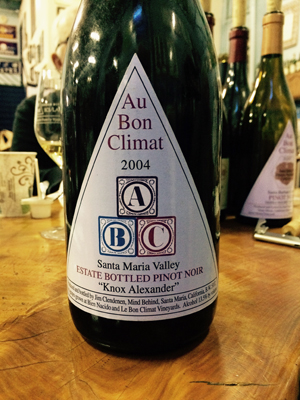 |
It’s always tough to judge barrel and tank samples, since most will be blended with other components for the finished wines – part of why I’ve avoided including them among my favorites for this Central Coast report as a whole. But since we tasted so many barrel samples with Bob and Louisa, I wanted to make note of the ones I thought were most promising. These included the Qupé 2015 Sawyer Lindquist Vineyard Viognier, Qupé 2015 Bien Nacido Roussanne, Au Bon Climat 2014 Sanford & Benedict Vineyard 100% whole-cluster Pinot Noir, Verdad 2014 Sawyer Lindquist Vineyard Tempranillo, Verdad 2014 Sawyer Lindquist Vineyard Grenache, and Verdad 2014 Pine Hawk Vineyard Cabernet Sauvignon. And among the bottled wines we had with our lunch, my favorites were the Verdad 2014 Sawyer Lindquist Vineyard Albariño, Clendenen Family 2013 Le Bon Climat Vineyard Viognier, Qupé 2012 “Sonnie’s” Syrah, and 2004 Au Bon Climat “Knox Alexander” Pinot Noir. Wow, that was a lot of really good wine! And the others that we tasted were quite nice as well.
Our visit with Bob, Louisa, and Jim was without question a highlight of our trip. Many noteworthy wines, a fantastic lunch (thanks, Jim!), and plenty of informative and entertaining conversation with three of Santa Barbara County’s finest vintners. It’s not every day that you’re hosted by two of the region’s real wine pioneers as well as one who’s helped pioneer a whole new group of grape varieties in California. This visit was certainly a memorable one for Eric, Michael, Alan, and me, and we’re very appreciative of the generous hospitality that Bob, Louisa, and Jim showed us. Their wineries may no longer be new discoveries, but they’ve never stopped striving – and succeeding – to set the quality bar higher, and our visit showed that we’ll continue to see plenty of outstanding wines from all of them in the coming years.
Alma Rosa Winery & Vineyards
Tasting Notes: Current Releases |
Alma Rosa 2013 Blanc de Blancs, Sta. Rita Hills. 50% each Pinot Blanc and Chardonnay. Light color, this had subtle pear and stone fruit aromas along with yeasty undertones. Bright and elegant, with very fine bubbles and a vibrant finish.
Alma Rosa 2013 Brut Rosé, El Jabalí Vineyard, Sta. Rita Hills. Entirely from Mt. Eden clone Pinot Noir. Light salmon color, with fresh strawberry, earth, yeast, and slightly floral notes. Medium-light weight with a fine bead and pleasant finish, nice.
Alma Rosa 2014 Pinot Blanc, Sta. Rita Hills. Light straw color, this featured fresh pear fruit with notes of spice and wet stone. Medium-light bodied with lively acidity and a clean finish, nice.
Alma Rosa 2014 Chardonnay, El Jabalí Vineyard, Sta. Rita Hills. Slightly darker color, with stone fruit and tropical fruit aromas along with earth, spice, and a touch of vanilla/oak. Moderately rich and creamy on the palate, with a long finish.
Alma Rosa 2011 Pinot Noir, “Mt. Eden Clone,” El Jabalí Vineyard, Sta. Rita Hills. Medium-light ruby color, this had floral scents upfront, plus black cherry fruit, earth, and herbs. Medium-bodied, this finished with fine tannins.
Alma Rosa 2012 Pinot Noir, “Mt. Eden Clone,” El Jabalí Vineyard, Sta. Rita Hills. Medium-light ruby color, showing riper plummy fruit with savory/meaty and smoky overtones. A bit richer on the palate than the previous wine but retaining a lively texture, finishing with firmer tannins – nice, and has good potential for aging.
Alma Rosa 2013 Pinot Noir, Sta. Rita Hills. Medium ruby color, with black cherry, tea leaf, spice, hints of flowers on the nose, and a dash of sweet oak. Medium weight in the mouth with good structure, and finishing with moderate tannins.
Alma Rosa 2013 Pinot Noir, “Clone 115,” Sta. Rita Hills. Slightly lighter color, displaying pretty floral aromas plus black cherry fruit with savory and herbal notes. Medium-light weight with lively acidity and fine tannins on the finish, nice.
Alma Rosa 2013 Pinot Noir, “Clone 667,” Sta. Rita Hills. Medium ruby, this had a bolder, darker fruit profile along with more earth, spice, and oak on the nose. Bigger mouthfeel with more grip on the finish – a more structured Pinot that will need some time to develop.
Alma Rosa 2013 Pinot Noir, “Barrel Select,” Sta. Rita Hills. An almost electric ruby color, featuring both floral and savory aromas with black cherry, earth, and vanilla/oak notes. Medium-bodied with a silky texture and refined tannins on the long finish – very tasty now but should age nicely too.
|
|
I thought we were running really late for our next appointment by the time we left the Clendenen / Lindquist Winery and I was ready to call ahead when I realized we were due at 3:30, not 3pm. Wow, I really planned all this much better than I’d thought! We backtracked our route through the small town of Sisquoc and south to Highway 101, then headed to Buellton. We rolled into the parking lot right on time and walked up to the tasting room of Alma Rosa Winery & Vineyards, next door to Industrial Eats where we’d had lunch the day before.
Inside the airy new tasting room, we were greeted by Alma Rosa winemaker Nick de Luca. Nick told us that proprietor Richard Sanford would be there in a few minutes but we could follow him into the private tasting room at the back of the space. Nick has worked in Santa Barbara County for 11-12 years, and he joined Alma Rosa just before harvest in 2014. He’d had his own Ground Effect label before that – the label is still around but Nick is no longer involved – and he’d previously been the winemaker at Dierberg / Star Lane. I was happy to finally meet Nick – I’d tried to schedule an appointment to visit him a couple of times in the past few years but we were never able to find a time to meet before this.
Richard Sanford is among the true legends of Santa Barbara County wine. He was one of the first to recognize the potential of the Santa Rita Hills region for growing top-quality Pinot Noir, and an early proponent of organic viticulture and other sustainable practices. His career has gone through more than its share of ups and downs over the 45 years that he’s been a vintner – I won’t go into detail about that too much, but fortunately things are on an upswing for Richard and Alma Rosa right now. After earning a degree in geography from UC Berkeley, Richard was drafted into the armed forces and served as a naval officer in Vietnam. It was a difficult time for him, as he opposed the war, but one small incident helped point toward his future. A fellow naval officer gave him a bottle of Volnay, and this sparked his interest in wine – Pinot Noir in particular.
After returning from his service, Richard put his background in geography to good use in trying to find a spot in California where he could grow Pinot Noir to make as fine a wine as that Volnay. He came upon the unique geography of Santa Barbara County, with its east-west hills allowing cool air in from the ocean to temper the climate. After further investigation into the climate and soil, Richard formed a partnership to purchase property in the Santa Rita Hills, and he planted the first Pinot Noir in the region in 1971 at Sanford & Benedict Vineyard. He also planted Chardonnay, Riesling, Merlot, and Cabernet at the site, though the Bordeaux varieties didn’t fare as well in that cooler area.
Richard met his future wife Thekla in 1976 – they married two years later, and in 1981 they founded Sanford Winery, which became one of Santa Barbara’s leading producers of Pinot Noir and Chardonnay. In 1983, Richard planted his own El Jabalí Vineyard – it was farmed organically from the start, one of the first organic vineyards in Santa Barbara County. He continued to develop more estate vineyards in the same area – La Rinconada in 1995 and La Encantada in 2000, all of which were certified organic. In the early 2000s, Richard entered into a business relationship for Sanford Winery that helped fund a new winery facility at La Rinconada, but ultimately that relationship unraveled and Richard left the winery in 2005.
Richard and Thekla soon formed a new winery, Alma Rosa, and picked up where they left off in producing some standout wines, particularly Pinot Noir. But they never quite regained their financial footing, and in 2014 Alma Rosa was purchased by Bob Zorich, founder of a private equity firm who has a home in Santa Barbara. The good news is that Richard and Thekla have stayed on to head up the winery, and their daughter Blakeney is involved as well. They’ve also retained access to the organically-farmed vineyards at El Jabalí and La Encantada. As we talked with Richard during our visit, it was clear that he’s excited about his new relationship with Bob Zorich and the promise that Bob’s new investments in the winery and vineyards will bring going forward.
We sat around one end of a long wood table in the room, and Nick started us off with a couple of Alma Rosa sparkling wines while we waited for Richard to arrive. Both the 2013 Blanc de Blancs and 2013 Brut Rosé were released in December 2015 and are Alma Rosa’s first sparklers. The Blanc de Blancs is composed of 50% each Pinot Blanc and Chardonnay from sourced from La Encantada and El Jabalí vineyards, picked at 18-19 brix, tank-fermented and barrel-aged with 1.5 years en tirage. The Brut Rosé was picked about 19.5 and is entirely from Mt. Eden clone Pinot Noir at El Jabalí Vineyard, planted with budwood from Sanford & Benedict. Nick told us that Richard originally conceived of the Alma Rosa label as specializing in sparkling wines. While Alma Rosa’s still wines are made at the nearby Terravant facility, the sparklers are currently made at Rack & Riddle in Hopland.
Richard joined us as we were tasting the two sparkling wines and talked with us about his vineyards. As you might guess from knowing the locations of the vineyards he’s developed over the years, he likes working with sites on north-facing slopes that are located on the south side of the Santa Ynez River along Santa Rosa Road. He’s planning new plantings at El Jabalí Vineyard and noted that more of them will be on clay soil there, as plantings on clay have done well at other nearby sites. There will be various clones of Chardonnay and Pinot Noir, and he’ll be adding Syrah and Grenache as well, a total 36 acres that will be farmed biodynamically. Richard is happy to now have the financial backing to do this.
Our next wine was a 2014 Pinot Blanc, sourced entirely from La Encantada Vineyard – that site is planted mostly to Pinot Noir but there’s a little Pinot Blanc and Pinot Gris too. Alma Rosa has made some of my favorite California Pinot Blancs over the years. 2014 El Jabalí Vineyard Chardonnay is in a bigger, richer style than the Alma Rosa Santa Barbara County Chardonnay bottling – Richard said he thinks of this one as more Meursault-style whereas the other is more inspired by Chablis. Richard and Nick pointed out the new labels on the Alma Rosa bottles – simplified from the old design and easier to read. It was about this time when Nick had to take off, and we continued our tasting with Richard.
Although we didn’t taste them on this visit, Alma Rosa also produces Pinot Gris and a Pinot Noir Vin Gris. The rest of our tasting was Pinot Noir, the grape variety with which Richard and Alma Rosa are most closely identified. For a number of years, Alma Rosa had produced several separate clonal bottlings of Pinot, and we tasted both 2011 and 2012 vintages of the “Mt. Eden Clone” from El Jabalí. Both were quite distinct, with the 2011 being more floral and the 2012 more savory and earthy. Richard told us that he’s aiming for his Pinots to be Volnay-like, on the light and elegant side, his favorite style of Burgundy and his introduction to the grape variety.
|
| Richard Sanford, Nick de Luca |
We asked Richard whether he’s used any whole-cluster fermentation in recent years (it was always a no-no for the old Sanford wines), and he said he’s done some on certain lots but it’s always a harvest day decision as it depends on the condition of the stems. The Pinots are fermented in open-top tanks, with punchdowns. In general, the winemaking is gentle, and Richard likes to keep the Pinot on the lees for a fairly long time in barrel. With the exception of the sparklers, all of the Alma Rosa wines are all bottled under screwcap. After comparing different closure options, Richard felt screwcaps worked well for his wines – he finds that Pinots age nicely under screwcap but retain more freshness and fruit than with cork closures.
Four different 2013 Pinots concluded our tasting with Richard. The 2013 Sta. Rita Hills Pinot was sourced from El Jabalí , La Encantada, and a couple of other sites. Richard said future bottlings will be Santa Barbara County rather than Sta. Rita Hills to gain a broader choice of vineyard sources. Next were two more clonal bottlings, from 115 and 667 clones sourced from various Sta. Rita Hills vineyards, and the two were certainly different from one another – I preferred the more floral 115 bottling. Our final wine was the “Barrel Select” – as the name implies, it’s a selection put together of barrels from different lots that blend together well. This was a beautiful wine, my favorite of all the Alma Rosa Pinots.
Richard shared some exciting news with us. Not surprisingly, he would prefer to have more control over winemaking than he’s able to have at Terravant – for example, he’d like to barrel-age his Pinots for a longer time – and he is now working on a new winemaking facility in Lompoc. The idea is that this will serve for the next few years, and ultimately he’ll build a new winery at the Rancho El Jabalí property. Along with his plans for new vineyard planting, the financial backing he’s receiving from the new winery ownership is allowing him to take these steps forward.
This was a wonderful opportunity to taste the latest Alma Rosa wines with Richard and Nick. Nick has been one of the bright young vintners on the Santa Barbara wine scene for the past decade, and it’s always a pleasure to talk with Richard. Most of the pioneer Santa Barbara vintners we visited have a low-key charm to them, but Richard seems to carry an additional sense of calm and grace that’s rare in the wine world. I’ve been a fan of the Alma Rosa wines from the start – I’ve found that they generally do a fine job of combining bright, ripe aromatics with good acidity and lively texture. I felt the standouts of our tasting included the Brut Rosé, Pinot Blanc, the 2012 “Mt. Eden Clone” Pinot Noir, and the 2013 “Clone 115” and “Barrel Select” Pinot Noirs. The wines are not inexpensive but they’re quite reasonable for the quality and the track record of a winery such as Alma Rosa. With his new business arrangement with Bob Zorich, Richard has begun another chapter in his wine journey, and it sounds like there’s an exciting future ahead for Alma Rosa. Richard told us that he’s determined to never compromise his values – that’s been the case through all his ups and downs over the years, and I’m sure that’s one thing that will not change.
We didn’t have far to go back to our motel, so unlike the past couple days, we were able to relax for a short time before dinner. It was also a short drive for dinner at The Hitching Post II restaurant in Buellton. I usually try to take advantage of the Hitching Post’s Monday burger night when I’m in the area. Served only in the bar area where they don’t take reservations, the burgers there are worth the wait for a table. We met our friend John Tomasso there, and he’d already put our group in for a table, so it wasn’t a long wait at all. Winemaker Karen Steinwachs of Buttonwood Farm Winery was joining us for dinner as well, and she arrived just a couple of minutes after the rest of our group. While we were waiting, Hitching Post owner Frank Ostini came out to the waiting area to talk with us – it was one of the few times I’ve seen him without his trademark pith helmet!
As usual, our burgers and fries were delicious, and as usual, everyone brought wine to enjoy with them. Karen brought one of her newest bottlings, not yet released. The Buttonwood 2012 “Classic Cuvée” is a Bordeaux-style blend from the winery’s estate vineyard that Karen described as the “ultimate hamburger wine.” Although I didn’t take notes on this wine, I remember enjoying it and Eric mentioned “I liked it” – high words of praise from him! The Hitching Post is always a good place to spot local winemakers, and on this occasion I saw Chris Bratcher with some of his friends at the bar. I’d met him a few years earlier – he has own his Bratcher Winery label – but I hadn’t seen him since he suffered a serious injury at the winery in 2014, so it was good to see Chris doing as well as he is, and in great spirits.
We said our good-byes to John and to Karen and headed back to the motel – we were all hoping to get an early start the next morning as we wrapped up our wine tour and tried to beat the traffic on our respective drives back home.
This was a particularly memorable Santa Barbara County wine tour for me. It was a rare opportunity to able to talk and taste with so many vintners who are truly legends of their region. Visiting with Santa Barbara wine pioneers Ken Brown, Rick Longoria, Bob Lindquist, Jim Clendenen, and Richard Sanford, and with winemaker Fabian Bravo of Brander, was quite a special experience. All of these vintners have been committed over the years to making top-quality wines and to making them their way, regardless of the fashion of the day or the views of some critics. All of them were excited about the future of their wineries, and it was great to see that they’re making some of their best-ever wines now. As always, thanks to everyone that we visited for being so generous with their time and their wine!
|


(3).jpg)
